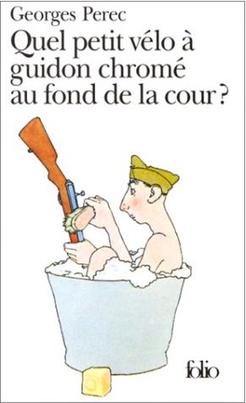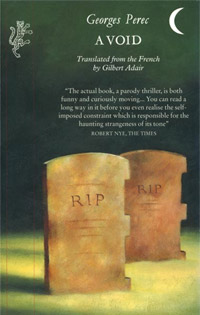
E, or e, is the fifth letter and the second vowel letter of the Latin alphabet, used in the modern English alphabet, the alphabets of other western European languages and others worldwide. Its name in English is e ; plural es, Es or E's.

Georges Perec was a French novelist, filmmaker, documentalist, and essayist. He was a member of the Oulipo group. His father died as a soldier early in the Second World War and his mother was killed in the Holocaust. Many of his works deal with absence, loss, and identity, often through word play.
A lipogram is a kind of constrained writing or word game consisting of writing paragraphs or longer works in which a particular letter or group of letters is avoided. Extended Ancient Greek texts avoiding the letter sigma are the earliest examples of lipograms.
Constrained writing is a literary technique in which the writer is bound by some condition that forbids certain things or imposes a pattern.
Oulipo is a loose gathering of (mainly) French-speaking writers and mathematicians who seek to create works using constrained writing techniques. It was founded in 1960 by Raymond Queneau and François Le Lionnais. Other notable members have included novelists Georges Perec and Italo Calvino, poets Oskar Pastior and Jean Lescure, and poet/mathematician Jacques Roubaud.

Life: A User's Manual is Georges Perec's most famous novel, published in 1978, first translated into English by David Bellos in 1987. Its title page describes it as "novels", in the plural, the reasons for which become apparent on reading. Some critics have cited the work as an example of postmodern fiction, but Perec preferred to avoid labels and his only long-term affiliation with any movement was with the Oulipo or OUvroir de LIttérature POtentielle.

Gadsby is a 1939 novel by Ernest Vincent Wright, written without words that contain the letter E, the most common letter in English. A work that deliberately avoids certain letters is known as a lipogram. The plot revolves around the dying fictional city of Branton Hills, which is revitalized as a result of the efforts of protagonist John Gadsby and a youth organizer.

Harry Mathews was an American writer, the author of various novels, volumes of poetry and short fiction, and essays. Mathews was also a translator of the French language.
Gilbert Adair was a Scottish novelist, poet, film critic, and journalist. He was critically most famous for the "fiendish" translation of Georges Perec's postmodern novel A Void, in which the letter e is not used, but was more widely known for the films adapted from his novels, including Love and Death on Long Island (1997) and The Dreamers (2003).
David Bellos is a British academic, translator and biographer. He is the Meredith Howland Pyne professor of French and comparative literature at Princeton University in the United States, and was director of its translation and intercultural communication programme from 2007 to 2019.

Hervé Le Tellier is a French writer and linguist, and a member of the international literary group Oulipo. He is its fourth president. Other notable members have included Raymond Queneau, Georges Perec, Italo Calvino, Jacques Roubaud, Jean Lescure and Harry Mathews. He won the 2020 Prix Goncourt for The Anomaly.
The Scott Moncrieff Prize, established in 1965, and named after the translator C. K. Scott Moncrieff, is an annual £2,000 literary prize for French to English translation, awarded to one or more translators every year for a full-length work deemed by the Translators Association to have "literary merit". The Prizes is currently sponsored by the Institut Français du Royaume Uni. Only translations first published in the United Kingdom are considered for the accolade.
Ian Monk is a British writer and translator, based somewhere in France.
Piero Falchetta is an Italian cartographer, writer and translator. He is head of the department of ancient maps at the Biblioteca Marciana in Venice and a specialist of medieval travel writing, history of cartography and history of navigation. He currently lives in his native Venice. One of his most recent contributions to medieval cartography is a critical edition of Fra Mauro's World Map, published in 2006. Recent contributions to the history of navigation are the essays on Michael of Rhodes' nautical writings, and the edition of Benedetto Cotrugli's treatise De navigatione (1464–65). He is also the author of literary essays and translations. His most notable translation is La scomparsa (1995) Italian translation on Georges Perec's lipogrammatic novel La disparition (1969), which was awarded the 1996 Leone Traverso debut prize in the Monselice Literary Prize.

Which Moped with Chrome-plated Handlebars at the Back of the Yard? is a comic novella by Georges Perec. Perec's second published work, it was originally published in 1966 in French as Quel petit vélo à guidon chromé au fond de la cour? The English translation by Ian Monk was published in Three by Perec by David R. Godine, Publisher in 2004. The Review of Contemporary Fiction called Monk's translation "gorgeous and eloquent".

Things: A Story of the Sixties is a 1965 novel by Georges Perec, his first.

A Man Asleep is a 1967 novel by the French writer Georges Perec. It uses a second-person narrative, and follows a 25-year-old student, who one day decides to be indifferent about the world. A Man Asleep was adapted into a 1974 film, The Man Who Sleeps.
Marcel Bénabou is a French writer and historian.
René Marill Albérès, or R. M. Albérès, was the pseudonym of René Marill, a French writer and literary critic. He published book-length studies of Antoine de Saint-Exupéry, André Gide, Gérard de Nerval, Jean Giraudoux, Jean-Paul Sartre, Michel Butor, Franz Kafka, as well as surveys of the novel in twentieth-century European literature.

Le Condottière is a posthumous novel by the French writer Georges Perec, originally written between 1957 and 1960, but published in 2012 by the publishing house Seuil, in its collection "Librairie du XXe et du XXIe siècles" directed by Maurice Olender.










